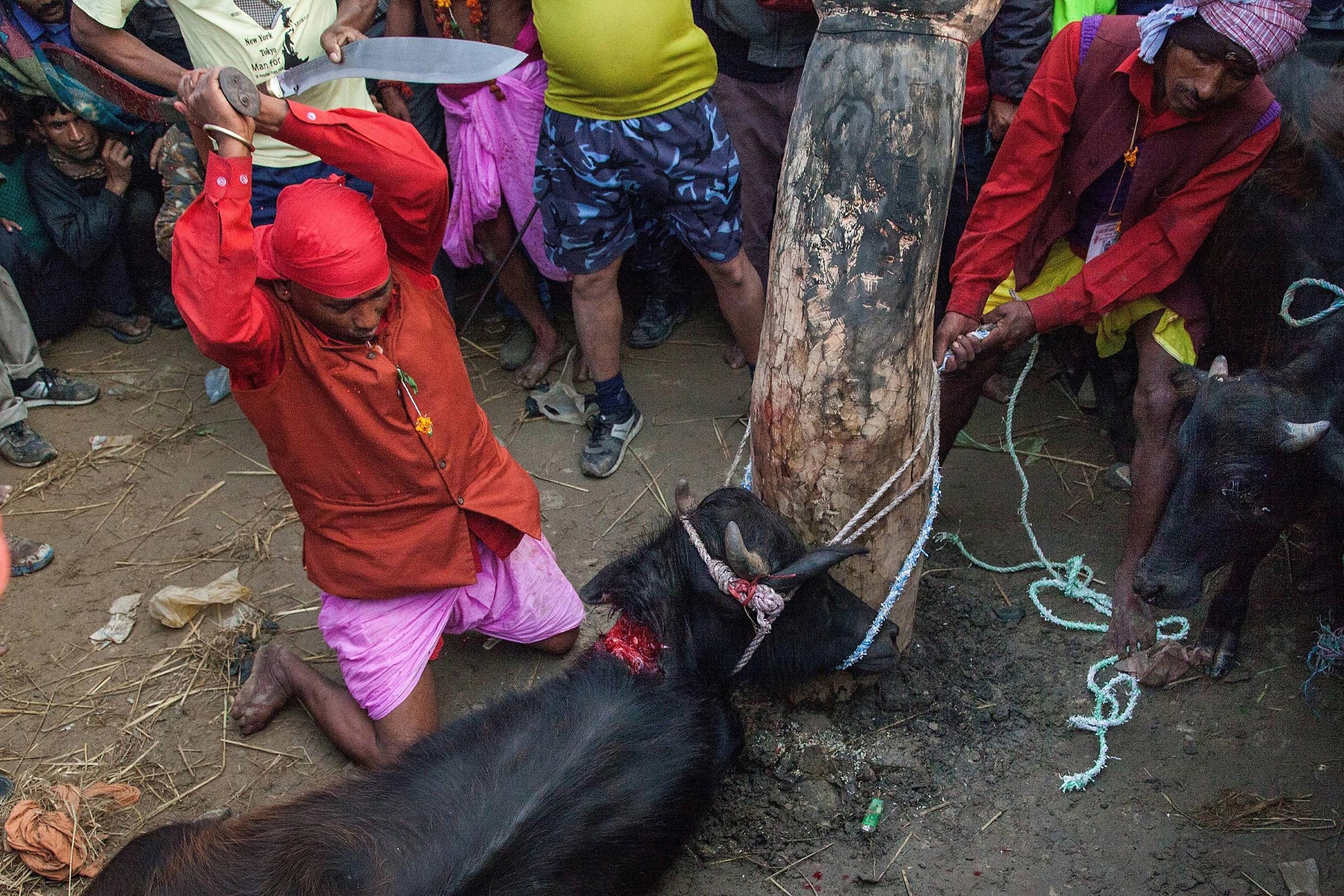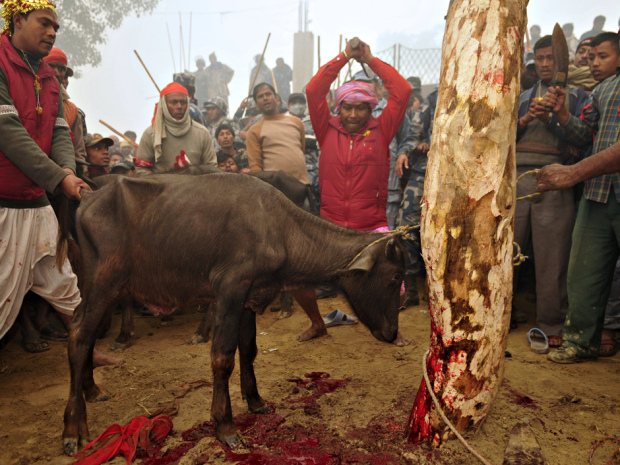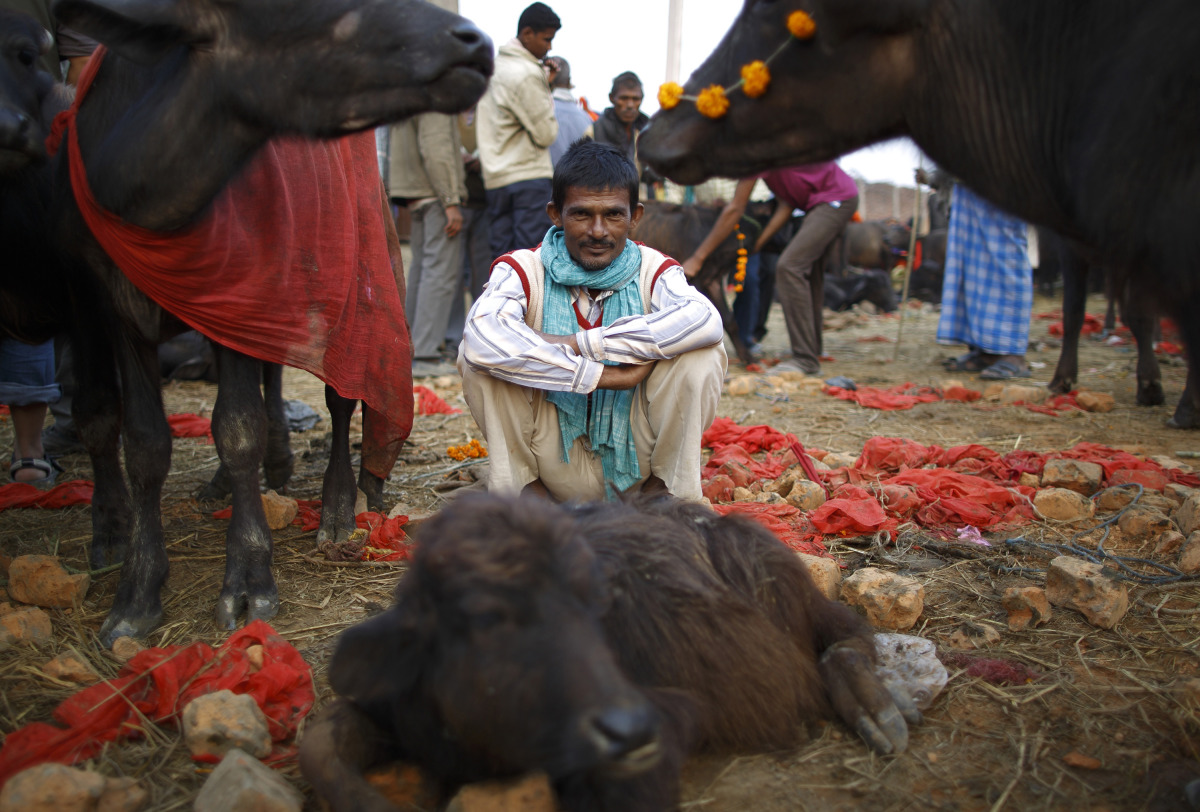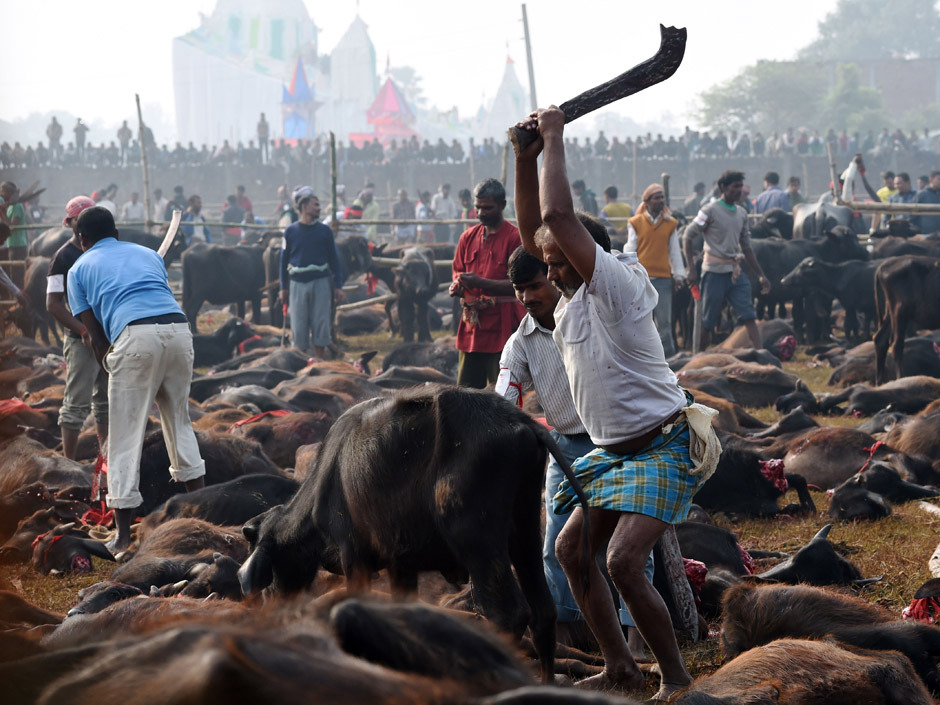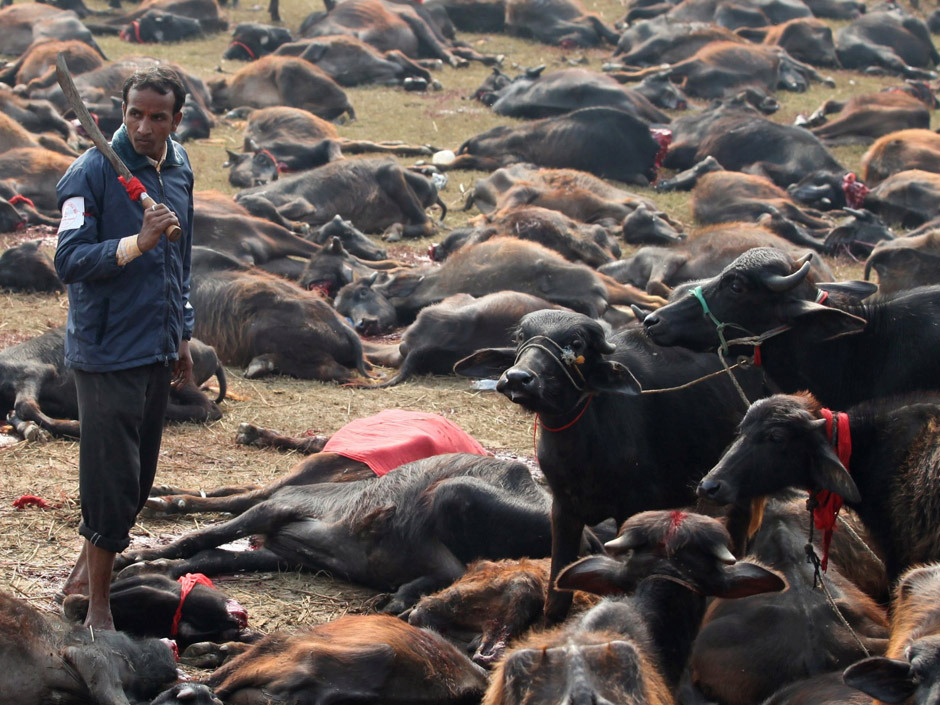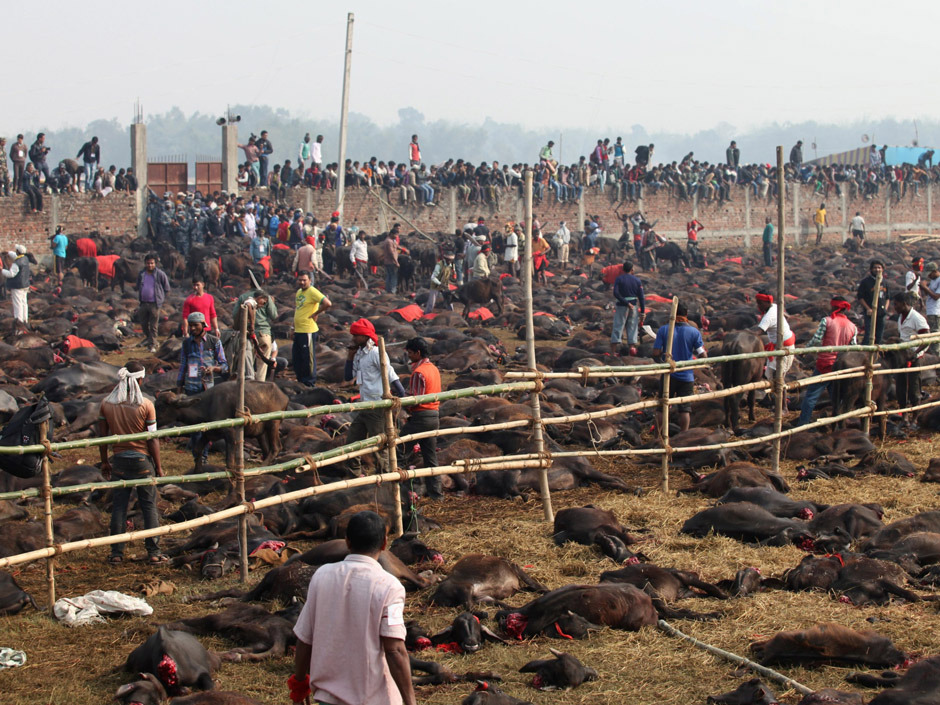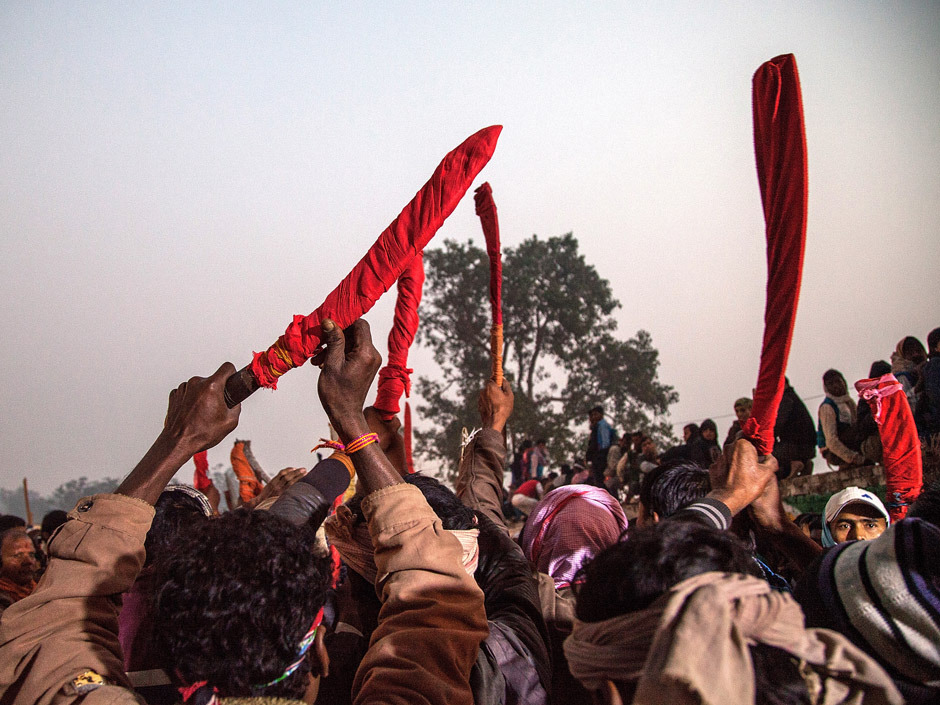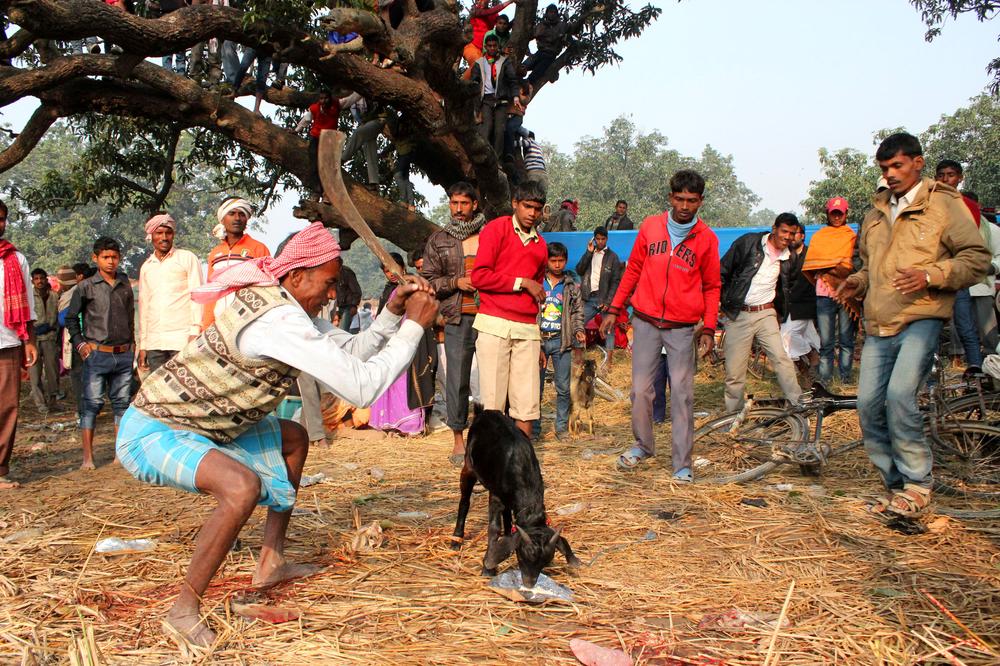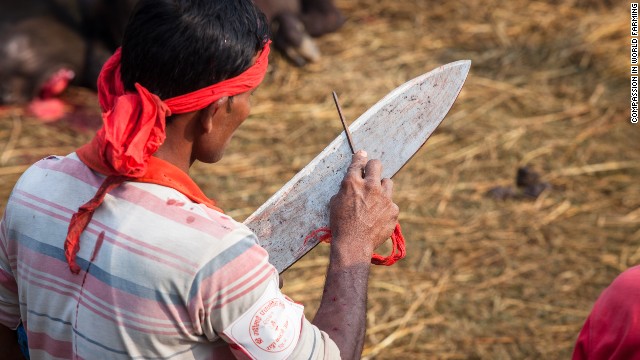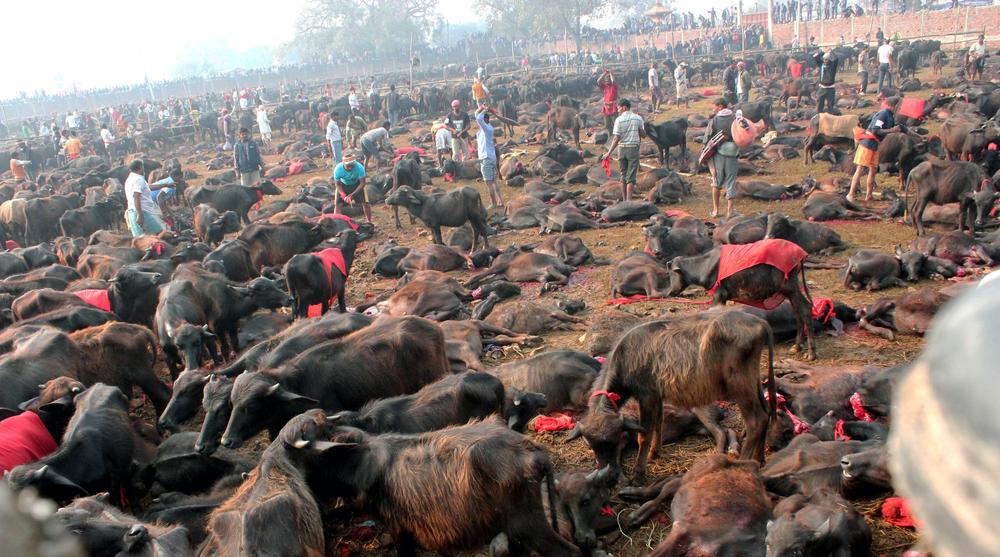In An Unparalleled Religious Madness, Some 5,000 Buffaloes Slaughtered In One Day
Barbaric slaughter or historic ritual? You decide!
In this image dated 28 November 2014, a Hindu devotee is seen slaughtering a water buffalo during the celebration of the Gadhimai festival in the Nepalese town of Bariyarpur. Held every five years and bringing in more than five million spectators, the festival is held with the goal of pleasing Gadhimai, the Hindu goddess of power. The death toll is as high as 500,000 animals.
In 2009, the last time the festival was held, sword-wielding Hindu devotees slaughtered an estimated 250,000 water buffaloes, sheep, goats and chickens in a frenzied, two-day period as thousands looked on. As reported by National Post, many of the animals are brought illegally over the border from India.
In this file photograph taken on 24 November 2009, a Nepalese Hindu devotee slaughters a buffalo as an offering to the Hindu goddess Gadhimai in Bariyapur village in Bara district some 70 km south of Kathmandu.
Image via nationalpost.comThought to be the world's largest animal sacrifice ritual, devotees believe the Gadhimai festival brings them good luck, and will encourage Gadhimai, the Hindu goddess of power, to answer their wishes. The ritual begins before dawn in the fields outside Gadhimai temple in Bariyarpur, where a priest trickles his own blood combined with that of a rat, chicken, pigeon, goat, and pig.
A herder sits inside an enclosure for buffalos awaiting sacrifice on the eve of the sacrificial ceremony for the "Gadhimai Mela" festival in Bariyapur 27 November 2014
Image via wordpress.comAs per a report by The Independent, to end the first day of the event, thousands of buffaloes enclosed in a compound surrounded by a high wall, were decapitated by a group of specially chosen 400 men using curved kukri knives. On the first half of the two day event held in the jungles of Bara district, some 5,000 buffaloes were killed – and many were yet to be slaughtered.
A butcher walks with a bloodied blade as he looks for an animal to kill during a mass slaughter of buffaloes for the Gadhimai festival inside a walled enclosure in the village of Bariyapur on Friday.
Image via nationalpost.comA butcher raises his blade over a buffalo calf before killing it during a mass slaughter of buffaloes for the Gadhimai festival inside a walled enclosure in the village of Bariyapur on Friday.
Image via nationalpost.comA butcher stands beside slaughtered buffaloes during a mass sacrifice ceremony at Gadhimai temple in the jungles of Bara district Friday.
Image via nationalpost.comButchers stand by hundreds of slaughtered buffaloes during a mass sacrifice ceremony at Gadhimai temple in the jungles of Bara district Friday.
Image via nationalpost.comA butcher slaughters a buffalo during a mass sacrifice ceremony at Gadhimai temple in the jungles of Bara district, Friday.
Image via nationalpost.comA butcher wields his kukri, a traditional Nepalese knife, over a buffalo calf right before severing its head during a mass slaughter of buffaloes for the Gadhimai festival inside a walled enclosure in the village of Bariyapur on Friday.
Image via nationalpost.comA devotee slaughters a water buffalo during the celebration of the Gadhimai festival on Friday in Bariyarpur, Nepal.
Image via nationalpost.comMost people who attend the festival are from neighbouring India, even though that country bans the export of animals for the festival. The measure, put into place after the 2009 festival, has halved the number of animals to be slaughtered this year. While organisers and the authorities defend the festival as a generations-old tradition, animal rights activists decry it as barbaric.
A group of devotees elevate as a blessing their traditional kukri knifes before the beginning of the animal sacrifices during the celebration of the Gadhimai festival on Friday in Bariyarpur, Nepal.
Image via nationalpost.comOne festival-goer, Rajesh Shah, told the Guardian that he promised Gadhimai he would sacrifice a goat in her honour if his business was successful, as he cooked the animal he had just killed. He added he kept his promise to Gadhimai despite hearing complaints about the event.
Shristi Singh Shrestha, an animal rights activist with Animal Welfare Network Nepal, told the newspaper she felt “sad” and “defeated” because the group was unable to stop the slaughter.
“However, the positive thing is that the number of animals killed has come down … We hope there will be no killing of any animal at the next festival,” she said.
A devotee stands holding a traditional kukri knife after sacrificing several goats outside the temple area during the celebration of the Gadhimai festival on Friday in Bariyarpur, Nepal.
Image via nationalpost.comAs Aljazeera reports, silent protests were held by animal rights groups outside the venue of sacrifice at Bariyarpur temple, as they tried to stop the sacrifice of animals. Animal-rights activists accused temple authorities of "cashing in on people's beliefs".
"They are extorting money ... in the name of entry fees, parking, and so on," said Manoj Gautam, president of Animal Welfare Network Nepal, who is in Bariyapur to protest against the ritual.
According to legend, the first sacrifices in Bariyapur were conducted several centuries ago when Gadhimai appeared to a prisoner in a dream and asked him to establish a temple to her.
When he awoke, his shackles had fallen open and he was able to leave the prison and build the temple, where he sacrificed animals to give thanks.
To date, activists have managed to save 2500 animals by talking devotees out of partaking in the ritual
Image via news.com.au"It's madness, it's really madness," said N.G. Jayasimha, director of the Humane Society International of India
Anyone can slaughter the animals, as long as they are Hindu. However, they need to get a license from the organising committee.
Image via aljazeera.com“There are no roads, no infrastructure, not a single public bus, no sanitation and no drinking water. There are human feces everywhere. A number of people have come, and everybody is carrying an animal to be sacrificed.”
“The sights and sounds are unimaginable,” wrote Jayasimha Nuggehalli director of the Indian branch of the Humane Society International. “Pools of blood, animals bellowing in pain and panic, wide-eyed children looking on, devotees covered in animal blood, and some people even drinking blood from the headless but still warm carcasses.”
Joginder Patel, a veteran of five Gadhimai festivals, told The Guardian that the job of killing the buffaloes was a great honour
“I really look forward to this. God will bless me for it,” said the 44-year-old. “It is as easy as cutting vegetables. At the last festival I beheaded 300 buffaloes, but this year I killed only 175.”
The two-day spectacle leaves pools of blood across the temple grounds, the air thick with the stench of raw meat, while authorities dump buffaloes' heads into a freshly dug large pit
